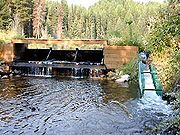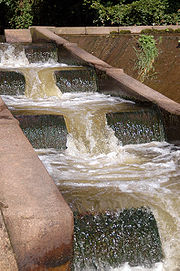
Fish ladder
Encyclopedia

Dam
A dam is a barrier that impounds water or underground streams. Dams generally serve the primary purpose of retaining water, while other structures such as floodgates or levees are used to manage or prevent water flow into specific land regions. Hydropower and pumped-storage hydroelectricity are...
s and lock
Lock (water transport)
A lock is a device for raising and lowering boats between stretches of water of different levels on river and canal waterways. The distinguishing feature of a lock is a fixed chamber in which the water level can be varied; whereas in a caisson lock, a boat lift, or on a canal inclined plane, it is...
s) to facilitate diadromous fishes' natural migration
Fish migration
Many types of fish migrate on a regular basis, on time scales ranging from daily to annually or longer, and over distances ranging from a few metres to thousands of kilometres...
. Most fishways enable fish to pass around the barriers by swimming and leaping up a series of relatively low steps (hence the term ladder
Ladder
A ladder is a vertical or inclined set of rungs or steps. There are two types: rigid ladders that can be leaned against a vertical surface such as a wall, and rope ladders that are hung from the top. The vertical members of a rigid ladder are called stringers or stiles . Rigid ladders are usually...
) into the waters on the other side. The velocity of water falling over the steps has to be great enough to attract the fish to the ladder, but it cannot be so great that it washes fish back downstream or exhausts them to the point of inability to continue their journey upriver.
History

Bathurst, New Brunswick
Bathurst is a Canadian city in Gloucester County, New Brunswick.Bathurst is situated on Bathurst Harbour, an estuary at the mouth of the Nepisiguit River at the southernmost part of Chaleur Bay....
, Canada who designed a fishway to bypass a dam at his water-powered lumber mill. In 1852–1854, the Ballisodare Fish Pass was built in County Sligo in Ireland to draw salmon
Salmon
Salmon is the common name for several species of fish in the family Salmonidae. Several other fish in the same family are called trout; the difference is often said to be that salmon migrate and trout are resident, but this distinction does not strictly hold true...
into a river that had not supported a fishery. In 1880, the first fish ladder was built in Rhode Island
Rhode Island
The state of Rhode Island and Providence Plantations, more commonly referred to as Rhode Island , is a state in the New England region of the United States. It is the smallest U.S. state by area...
, United States on the Pawtuxet Falls
Pawtuxet Village
Pawtuxet Village is a section of the towns of Warwick and Cranston, Rhode Island. It is located at the point where the Pawtuxet River flows into the Providence River and Narragansett Bay.- History :...
Dam. The ladder was removed in 1924, when the City of Providence
Providence, Rhode Island
Providence is the capital and most populous city of Rhode Island and was one of the first cities established in the United States. Located in Providence County, it is the third largest city in the New England region...
replaced the wood dam with a concrete
Concrete
Concrete is a composite construction material, composed of cement and other cementitious materials such as fly ash and slag cement, aggregate , water and chemical admixtures.The word concrete comes from the Latin word...
one. Concrete ladders are not always an improvement – the electric field-sensitive organs of the paddlefish
Paddlefish
Paddlefish are primitive Chondrostean ray-finned fishes. The paddlefish can be distinguished by its large mouth and its elongated, spatula-like snout, called a rostrum, which is longer than the rest of the head...
are overloaded in the proximity of the rebar
Rebar
A rebar , also known as reinforcing steel, reinforcement steel, rerod, or a deformed bar, is a common steel bar, and is commonly used as a tensioning device in reinforced concrete and reinforced masonry structures holding the concrete in compression...
and other metal used in concrete construction, preventing them from gaining access to their spawning grounds and contributing to a catastrophic decline in their numbers.
As the Industrial Age
Industrial Age
Industrial Age may refer to:*Industrialisation*The Industrial Revolution...
advanced, dams and other river obstructions became larger and more common, leading to the need for effective fish by-passes.
Types

There are five main types of fishways:
- Pool and weir
- Baffle fishway (Denil, Larinier, Alaskan Steeppass, or other baffle configuration)
- Fish elevator
- Rock-ramp fishway
- Vertical-slot fish passage
A pool and weir is one of the oldest styles of fish ladders. It uses a series of small dams and pools of regular length to create a long, sloping channel for fish to travel around the obstruction. The channel acts as a fixed lock to gradually step down the water level; to head upstream, fish must jump over from box to box in the ladder.
A baffle fishway uses a series of symmetrical close-spaced baffles in a channel to redirect the flow of water, allowing fish to swim around the barrier. Baffle fishways need not have resting areas, although pools can be included to provide a resting area or to reduce the velocity of the flow. Such fishways can be built with switchbacks
Hairpin turn
A hairpin turn , named for its resemblance to a hairpin/bobby pin, is a bend in a road with a very acute inner angle, making it necessary for an oncoming vehicle to turn almost 180° to continue on the road. Such turns in ramps and trails may be called switchbacks in American English, by analogy...
to minimize the space needed for their construction.
Baffles come in variety of designs. The original design for a Denil fishway was developed in 1909 by a Belgian scientist, G. Denil; it has since been adjusted and adapted in many ways. The Alaskan Steeppass, for example, is a modular prefabricated Denil-fishway variant originally designed for remote areas of Alaska.
A fish elevator or fish lift, as its name implies, breaks with the ladder design by providing a sort of elevator
Elevator
An elevator is a type of vertical transport equipment that efficiently moves people or goods between floors of a building, vessel or other structures...
to carry fish over a barrier. It is well suited to tall barriers. With a fish elevator, fish swim into a collection area at the base of the obstruction. When enough fish accumulate in the collection area, they are nudged into a hopper that carries them into a flume that empties into the river above the barrier.
On the Connecticut River
Connecticut River
The Connecticut River is the largest and longest river in New England, and also an American Heritage River. It flows roughly south, starting from the Fourth Connecticut Lake in New Hampshire. After flowing through the remaining Connecticut Lakes and Lake Francis, it defines the border between the...
, for example, a fish elevator lifts up to 500 fish at a time, 52 feet (15.85 m), to clear the Holyoke Dam. In its first year of operation, 1955, the Holyoke fish elevator carried 4,899 shad
Shad
The shads or river herrings comprise the genus Alosa, fish related to herring in the family Clupeidae. They are distinct from others in that family by having a deeper body and spawning in rivers. The several species frequent different areas on both sides of the Atlantic Ocean, Mediterranean Sea....
over the dam; by 2004, the typical annual number of fish lifted had risen to more than 500,000.
A rock-ramp fishway uses large rocks and timbers to create pools and small falls that mimic natural structures. Because of the length of the channel needed for the ladder, such structures are most appropriate for relatively short barriers.
A vertical-slot fish passage is similar to a pool-and-weir system, except that each "dam" has a narrow slot in it near the channel wall. This allows fish to swim upstream without leaping over an obstacle. Vertical-slot fish passages also tend to handle reasonably well the seasonal fluctuation in water levels on each side of the barrier.
See also

- Eel ladderEel ladderAn eel ladder is type of fish ladder designed to help eels swim past barriers, such as dams and weirs or even natural barriers, to reach upriver feeding grounds...
- Fish migrationFish migrationMany types of fish migrate on a regular basis, on time scales ranging from daily to annually or longer, and over distances ranging from a few metres to thousands of kilometres...
- Pitlochry fish ladderPitlochry fish ladderThe Pitlochry fish ladder is a fish ladder next to the Pitlochry Power Station on the River Tummel near Pitlochry, Perth and Kinross, Scotland that allows salmon to travel upstream during the breeding season.- Construction details :...
- Fish screenFish screenA fish screen is designed to prevent fish from swimming or being drawn into an aqueduct, cooling water intake, dam or other diversion on a river, lake or waterway where water is taken for human use. They are built to supply debris-free water without harming aquatic life...
External links
- A study of the hydraulics of flow over fishways
- Construction of a vertical slot fish passage and eel ladder for the St. Ours Dam (Richelieu RiverRichelieu RiverThe Richelieu River is a river in Quebec, Canada. It flows from the north end of Lake Champlain about north, ending at the confluence with the St. Lawrence River at Sorel-Tracy, Quebec downstream and northeast of Montreal...
, QuébecQuebecQuebec or is a province in east-central Canada. It is the only Canadian province with a predominantly French-speaking population and the only one whose sole official language is French at the provincial level....
) - Fish Passage Center
- Fish passes. Design, dimensions and monitoring, Food and Agriculture Organization of the United NationsUnited NationsThe United Nations is an international organization whose stated aims are facilitating cooperation in international law, international security, economic development, social progress, human rights, and achievement of world peace...
/Deutscher Verband für Wasserwirtschaft und Kulturbau (DVWK), Rome, 2002 ISBN 92-5-104894-0 ISBN 3-89554-027-7 ([ftp://ftp.fao.org/docrep/fao/010/y4454e/y4454e.zip Zip download] from FTP areaFile Transfer ProtocolFile Transfer Protocol is a standard network protocol used to transfer files from one host to another host over a TCP-based network, such as the Internet. FTP is built on a client-server architecture and utilizes separate control and data connections between the client and server...
of the FAO's EIFAC – European Inland Fisheries Advisory Commission) - Washington Post, January 31, 2007: U.S. Orders Modification of Klamath River – Dams Removal May Prove More Cost-Effective for allowing the passage of Salmon

